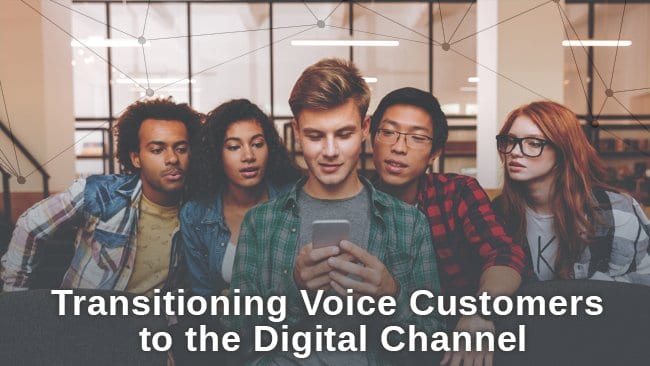
The millennial generation is vastly different from those that came before it. Far more technology focused than their predecessors, millennials understand what technology can achieve and therefore have far greater expectations when it comes to issues around service.
For them, service needs to be 24/7 and responses to queries need to be nearly instantaneous. Of course, ensuring that such a service is available doesn’t necessarily mean keeping agents sitting in a contact center at all hours of the day. Instead, an increasing number of organizations are turning to chatbots as a means of delivering automated self-service. Chatbots add a new dimension to today’s multichannel contact center environment, by allowing these centers to respond even to relatively complex tasks automatically.
Chatbots offer more than a new means to provide 24/7 service; a combination of these solutions and human agents, with the right skills, looks like being the answer to many of the current woes faced by centers struggling to deliver the most effective and efficient customer service.
After all, these bots are able to assist in maximizing agent productivity, by eliminating the need for many of the more monotonous and mundane customer service tasks to be carried out by humans. In this way, chatbots are able to enhance a center’s service capabilities, by ensuring that human agents are freed up to tackle the complex customer service issues.
It should be clear then that chatbots form an important part of the digital transformation initiatives many customer service facilities are undertaking. The trouble with these new digitization strategies is that while they offer many clear benefits to organizations, they are still initiatives that only impact on those customers who interact with the center via its web platform.
Anyone who uses the voice channel – and this is still the largest majority of customers – for any service that is beyond the capabilities of a standard interactive voice response (IVR) tool will be directed to a human agent. The trouble here is that organizations are now increasingly investing in digital technologies, and yet these are all too often being skipped over by more than half their customers, who are instead utilizing a channel that is inherently more expensive to the provider.
It is for this reason that Visual IVR offers businesses the best of both worlds. Visual IVR is a support platform that guides inbound callers to a web-based support experience. It allows them to transition from a voice call and instead opt into a digital session, which in effect, personalizes the support journey for customers already on their way to the queue. Moreover, this technology is designed to seamlessly connect customers to self-service options and/or a support resource that can solve their problem/inquiry at first contact.
Furthermore, should the customer still need additional assistance, beyond what the digital service can offer, Visual IVR also allows these customers to transition back from the digital channel to an agent with full context, resulting in significantly reduced handle times and increased customer satisfaction.
While this does not mean that there is no longer room for voice IVR – it certainly remains a key tool in your inventory – visual IVR can be used to transition customers to the digital experience, making their lives easier, while at the same time not only reducing the demand on your voice channel but also exposing customers to the digital arena. In this way, you are obtaining better traction on your investments in digital while at the same time saving on the costs associated with the voice channel.
Visual IVR is thus something that you need to be implementing sooner, rather than later if you hope to reduce the volume of calls coming in to your voice channel. Remember, though, that ultimately the aim of placing the digital options in front of customers is not to force a particular channel on them, but rather to give them access to whichever one is most convenient for them at the time.
Ultimately you want to be able to provide a genuinely multichannel experience for your customers. But in doing so, you need to ensure that such an experience remains consistent across multiple touch points – thereby enabling customers to make contact via the channel of their choice, without any difference being felt or quality lost across the various mediums.
According to a recent Accenture Report¹, a growing number of modern customers expect to receive an always-on personal digital experience. This makes a case for digital service channels being critical for boosting customer retention. Accenture points to the fact that 40 percent of customers actually want their providers to offer more digital service options.
Furthermore, it indicates that online support provided in the form of corporate websites, forums, online chats and mobile apps is the preferred channel for customer service and support by a wide margin. This, in turn, further makes a case for Visual IVR as a means to transition voice customers over to the ‘sexier’ digital channels.
In the end, states Accenture, organizations that seek to optimize their growth potential and deliver the experiences customers demand will need to balance their digital exuberance with a human touch. In other words, while you may seek to automate the easier tasks, and you may even want to reduce the number of calls to the more costly voice channel, you still need to ensure you have a strategic mix of digital and non-digital options available. In this way, you will enable your customers to engage with you in a multitude of highly satisfying ways.
[About the author] Dylon Mills is the Director of Marketing Content Strategy & Development at Uniphore. As such, Dylon’s main responsibilities are to strategize, create and deliver content for Uniphore’s product portfolio that align with the global Go-To-Market strategy, corporate positioning, and marketing campaigns. Dylon’s prior work experience includes Product Management at one of the top Fortune 500 Technology companies, Symantec Corporation. Outside of work, Dylon enjoys problem-solving and any project that includes building/tinkering with tools. Dylon holds a BS Consumer Economics from the University of Georgia.
Dylon Mills is the Director of Marketing Content Strategy & Development at Uniphore. As such, Dylon’s main responsibilities are to strategize, create and deliver content for Uniphore’s product portfolio that align with the global Go-To-Market strategy, corporate positioning, and marketing campaigns. Dylon’s prior work experience includes Product Management at one of the top Fortune 500 Technology companies, Symantec Corporation. Outside of work, Dylon enjoys problem-solving and any project that includes building/tinkering with tools. Dylon holds a BS Consumer Economics from the University of Georgia.
1 https://www.accenture.com/us-en/insight-digital-disconnect-customer-engagement
)